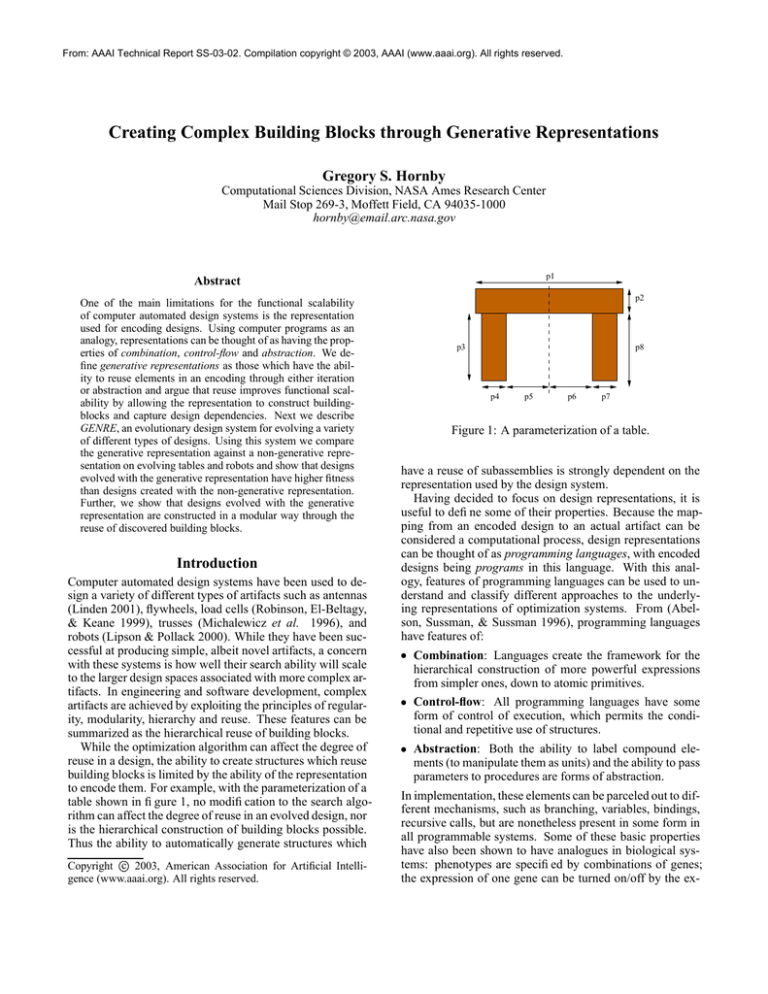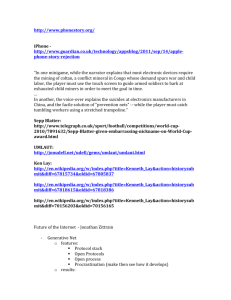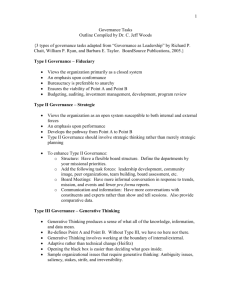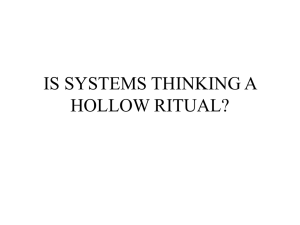
From: AAAI Technical Report SS-03-02. Compilation copyright © 2003, AAAI (www.aaai.org). All rights reserved.
Creating Complex Building Blocks through Generative Representations
Gregory S. Hornby
Computational Sciences Division, NASA Ames Research Center
Mail Stop 269-3, Moffett Field, CA 94035-1000
hornby@email.arc.nasa.gov
p1
Abstract
One of the main limitations for the functional scalability
of computer automated design systems is the representation
used for encoding designs. Using computer programs as an
analogy, representations can be thought of as having the properties of combination, control-flow and abstraction. We define generative representations as those which have the ability to reuse elements in an encoding through either iteration
or abstraction and argue that reuse improves functional scalability by allowing the representation to construct buildingblocks and capture design dependencies. Next we describe
GENRE, an evolutionary design system for evolving a variety
of different types of designs. Using this system we compare
the generative representation against a non-generative representation on evolving tables and robots and show that designs
evolved with the generative representation have higher fitness
than designs created with the non-generative representation.
Further, we show that designs evolved with the generative
representation are constructed in a modular way through the
reuse of discovered building blocks.
Introduction
Computer automated design systems have been used to design a variety of different types of artifacts such as antennas
(Linden 2001), flywheels, load cells (Robinson, El-Beltagy,
& Keane 1999), trusses (Michalewicz et al. 1996), and
robots (Lipson & Pollack 2000). While they have been successful at producing simple, albeit novel artifacts, a concern
with these systems is how well their search ability will scale
to the larger design spaces associated with more complex artifacts. In engineering and software development, complex
artifacts are achieved by exploiting the principles of regularity, modularity, hierarchy and reuse. These features can be
summarized as the hierarchical reuse of building blocks.
While the optimization algorithm can affect the degree of
reuse in a design, the ability to create structures which reuse
building blocks is limited by the ability of the representation
to encode them. For example, with the parameterization of a
table shown in figure 1, no modification to the search algorithm can affect the degree of reuse in an evolved design, nor
is the hierarchical construction of building blocks possible.
Thus the ability to automatically generate structures which
Copyright c 2003, American Association for Artificial Intelligence (www.aaai.org). All rights reserved.
p2
p3
p8
p4
p5
p6
p7
Figure 1: A parameterization of a table.
have a reuse of subassemblies is strongly dependent on the
representation used by the design system.
Having decided to focus on design representations, it is
useful to define some of their properties. Because the mapping from an encoded design to an actual artifact can be
considered a computational process, design representations
can be thought of as programming languages, with encoded
designs being programs in this language. With this analogy, features of programming languages can be used to understand and classify different approaches to the underlying representations of optimization systems. From (Abelson, Sussman, & Sussman 1996), programming languages
have features of:
Combination: Languages create the framework for the
hierarchical construction of more powerful expressions
from simpler ones, down to atomic primitives.
Control-flow: All programming languages have some
form of control of execution, which permits the conditional and repetitive use of structures.
Abstraction: Both the ability to label compound elements (to manipulate them as units) and the ability to pass
parameters to procedures are forms of abstraction.
In implementation, these elements can be parceled out to different mechanisms, such as branching, variables, bindings,
recursive calls, but are nonetheless present in some form in
all programmable systems. Some of these basic properties
have also been shown to have analogues in biological systems: phenotypes are specified by combinations of genes;
the expression of one gene can be turned on/off by the ex-
design representations
open−ended
representations
parameterization
non−generative
direct
indirect
generative
implicit
explicit
Figure 2: Classes of design representations.
pression of another gene (Lewin 2000); and an upstream
protein can control a downstream protein’s activity through
a signaling pathway (Alberts et al. 2002).
The meanings of combination, control-flow and abstraction translate almost directly from properties of programming languages to properties of design representations.
Combination refers to the ability to create more complex expressions from the basic set of commands in the language.
While the subroutines of GLib (Angeline & Pollack 1994)
and genetic programming (GP (Koza 1992)) allow explicit
combinations of expressions, combination is not fully enabled by mere adjacency or proximity in the strings utilized
by typical representations in genetic algorithms. Two types
of control-flow are conditionals and iterative expressions.
Conditionals can be implemented with an if-statement, as
in GP, or a rule which governs the next state in a cellular automata (CA). Iteration is a looping ability, such as the repeat
structure in cellular encoding (Gruau 1994), or embedded in
the fundamental behavior of CA’s. Abstraction is the ability
to encapsulate part of the genotype and label it such that it
can be used like a procedure, such as with automatically defined functions (ADFs) in GP or automatically defined subnetworks (ADSNs) in cellular encoding. Abstraction can be
seen when subfunctions can take parameters, as with ADFs.
The different types of representations for computerautomated design systems can be classified by how they encode designs. First, designs can be split into parameterizations or open-ended representations. Parameterizations consist of a set of values for dimensions of a pre-defined structure, such as the table in figure 1, and have no properties of
combination, control-flow or abstraction. Since one of the
goals of automated design systems is to achieve truly novel
artifacts, we focus on open-ended representations, those in
which the topology of a design is changeable, because it is
difficult for a parameterization to achieve a type of design
that was not conceived of by its creators. A fundamental
distinction between open-ended representations is whether
it is non-generative or generative. With a non-generative
representation each representational element of an encoded
design can map at most once to an element in a designed
artifact. The two subcategories of non-generative representations are direct and indirect representations. With a direct
representation, the encoded design is essentially the same as
the actual design, and with an indirect representation there is
a translation, or construction process, in going from the encoding to the actual design. A generative representation is
one in which an encoded design can reuse elements of its encoding in the translation to an actual design through either
abstraction or iteration (a form of control-flow). The two
subcategories of generative representations are implicit and
explicit. Implicit, generative representations consist of a set
of rules that implicitly specify a shape, such as through an
iterative construction process similar to a cellular automata
(CA) and explicit, generative representations are a procedural approach in which a design is explicitly represented by an
algorithm for constructing it. Thus implicit representations
can be thought of as a direct representation with reuse, and
explicit representations can be thought of as indirect representations with reuse. This hierarchy of design representations is shown in figure 2.
Both direct and indirect non-generative representations
are limited in their ability to scale to complex structures because of the exponential growth in the size of the design
space and because the increasing number of dependencies
in a design make it more difficult to make changes to a design. In the first case, as a design grows in the number of
parts the expected distance (in number of parts) between a
starting design and the desired optimized design increases.
Conversely, changing a single part makes a proportionately
smaller and smaller move towards the desired design. One
consequence of this is that as designs increase in the number
of parts, search algorithms require more steps to find a good
solution. Increasing the size of variation (by changing more
parts at a time) is not a solution because as the amount of
variation is increased, the probability of the variation being
advantageous decreases. The second case is similar: as designs become more complex, dependencies develop between
parts of a design such that changing a property of one part requires the simultaneous change in another part of the design.
For example, if the length of a table leg is changed, then all
of the other table legs must be changed or the table will become unbalanced. Non-generative representations are not
well suited to handling these increases in size and complexity because their language for representing designs is static.
Unlike a non-generative representation, a generative representation’s ability to reuse elements of an encoded design
improves the ability of search to navigate large design spaces
and improves scalability by capturing design dependencies
through the discovery of useful building blocks. First, navigation of large design spaces is improved through the ability
to manipulate assemblies of components as units. For example, if adding/removing an assembly of parts would make
a design better, this would require the manipulation of
elements of the design encoding with a non-generative representation. With a generative representation, abstraction allows for these assemblies to be inserted/deleted through the
change of a single symbol, and iteration allows for the addition/deletion of multiple copies of groups of parts through
changing the iteration counter. Secondly, reuse of elements
of an encoded design allows a generative representation to
capture design dependencies by giving it the ability to make
coordinated changes in several parts of a design simultane-
ously. For example, if all the legs of a table design are a
reuse of the same component, then changing the length of
that component will change the length of all table-legs simultaneously.
The advantages of generative representations are demonstrated by implementing a generic, evolutionary design system, GENRE– for GENerative REpresentations – and comparing a generative representation to a non-generative representation. GENRE consists of a design constructor and
evaluator, a compiler for the generative representation, and
an evolutionary algorithm. Each design is specified by a sequence of construction commands for building the artifact,
called an assembly procedure. With the non-generative representation, an individual’s encoding is an assembly procedure and with the generative representation, each individual
consists of a program which is then compiled into an assembly procedure. This programming language for encoding assembly procedures is based on Lindenmayer systems
(L-systems) (Prusinkiewicz & Lindenmayer 1990), which
are a type of grammar for producing sequences of characters (strings). By using an indirect, non-generative representation and an explicit, generative representation, these two
representations can be applied to different design substrates
by changing only the set of construction commands and the
design constructor.
In this paper the generative and non-generative representations are compared on the problem of design threedimensional tables out of cubes and locomoting robots. Results from evolving designs in these substrates show that the
evolutionary design system is capable of finding solutions of
higher fitness with the generative representation than with
the non-generative representation. Furthermore, images of
designs evolved with the generative representation show that
they are constructed in a modular way through the reuse of
discovered building blocks.
The rest of this paper is organized as follows. First we
describe the three parts of our evolutionary design system:
the compiler for the generative representation, the design
constructor and simulator, and the evolutionary algorithm.
Next we present the results of our experiments in evolving first tables (Hornby & Pollack 2001a) and then robots
(Hornby, Lipson, & Pollack 2001; Hornby & Pollack 2001b;
2002). This is followed by a discussion on the advantages
of generative representations for creating complex artifacts
and a summary of this paper.
Evolutionary Design System
The system used to create designs consists of the design
constructor and evaluator, the compiler for the generative
representation, and the evolutionary algorithm. Each design is constructed from a sequence of construction commands, called an assembly procedure. This string of construction commands is produced by the generative representation compiler. Our system uses Lindenmayer systems (Lsystems) as the generative representation for designs. The
evolutionary algorithm evolves a population of L-systems,
using the fitness returned by the design evaluator. The following subsections describe each of these parts.
L-systems as a Generative Representation
Language
The generative representation for our design system is based
on parametric Lindenmayer systems. Lindenmayer systems
(L-systems) are a type of grammar that was developed to
model the growth of natural organisms (Lindenmayer 1968).
Basic L-systems consist of a set of rewriting rules and differ
from the Chomsky hierarchy of grammars in that all symbols
in a string are rewritten in parallel. One extension of basic Lsystems is the class of parametric L-systems (Lindenmayer
1974) (PL-systems). This class differs from basic L-systems
in that the production rules of PL-systems have parameters,
there can be algebraic expressions applied to parameter values, and parameter values can also be used in determining
which production rule to apply. Production rules consists of
a rule-head, which is the symbol to be replaced, followed
by a number of condition-successor pairs. The condition is
a boolean expression on the parameters to the productionrule, and the successor consists of a sequence of characters
that replace the rule-head. For example in the production:
!
"$#&%'(()*
the condition is + and the
the predecessor is
A( , ),
successor is B( +1) c D( +0.5, -2). Rule-head symbols
are re-written by testing each of their conditions sequentially
and replacing the rule-head symbol with the successor of the
first condition that succeeds. For example, the PL-system,
, - ./01234 , 5).6.
, -./017234 , -#8
6./41*469-:*" , 5);3
6./417*469<#
-=8 , produces the following sequence of
when started with ,
strings,
, =>
, -?869-=8
, <*69<?6<*" , -?
, @369A*"B69@% , <*69<# , A*"6-?
, -#B69-#869<# , B69<*69<# , 6<*"B69@% , <*
, -#869<#6-# , -#B69-#869<# , <#B69-#869<# , 6<*"
, -#869<#6-# , -#B69-#869<# , <#B69-#869<# , <#6-#
Design Constructor
Strings produced by a PL-system can be used to construct
artifacts by assigning a meaning to each symbol in the string.
For example, the following PL-system specifies a family of
tree-like structures:
C #D-E#FGE#HI"% #JLK C 8E#NM% PO(QRS@3.TPU3V3W , V9XY<?
X8U3WZ[@3 C #YE#\)
C -E#FGE#HI"% #J^]\K9TPU3V3W , V9XY-E#.O&_-`9Tba @3dc8-=8
If this PL-system is started with P0(4), it produces the following sequence of strings,
1.
2.
3.
4.
5.
6.
P0(4)
[ P1(6) ] up(1) forward(3) down(1) P0(3)
[ [ forward(6) ] left(1) (4) ] up(1) forward(3)
down(1) [ P1(4.5) ] up(1) forward(3) down(1)
P0(2)
[ [ forward(6) ] left(1) (4) ] up(1) forward(3)
down(1) [ [ forward(4.5) ] left(1) (4) ] up(1)
forward(3) down(1) [ P1(3) ] up(1) forward(3)
down(1) P0(1)
[ [ forward(6) ] left(1) (4) ] up(1) forward(3)
down(1) [ [ forward(4.5) ] left(1) (4) ] up(1)
forward(3) down(1) [ [ forward(3) ] left(1) (4)
] up(1) forward(3) down(1)
[ [ forward(6) ] left(1) [ forward(6) ] left(1) [ forward(6) ] left(1) [ forward(6) ] left(1) ] up(1) forward(3) down(1) [ [ forward(4.5) ] left(1) [ forward(4.5) ] left(1) [ forward(4.5) ] left(1) [ forward(4.5) ] left(1) ] up(1) forward(3) down(1) [
[ forward(3) ] left(1) [ forward(3) ] left(1) [ forward(3) ] left(1) [ forward(3) ] left(1) ] up(1) forward(3) down(1) forward(3)
]
c
]
c
]
]
]
]
c
c
c
c
1992) and evolutionary programming (EP) (Fogel, Owens,
& Walsh 1966). Search operates by creating an initial population of candidate designs, called individuals, and then iteratively selecting better individuals to reproduce and make
new designs until the search is done. The evolutionary algorithm and variation operators are described in detail in
(Hornby 2003), here we give an overview of the system.
The initial population of L-systems is created by making
random production rules. Evolution then proceeds by iteratively selecting a collection of individuals with high fitness
for parents and using them to create a new population of
individual L-systems by applying mutation or recombination. Mutation creates a new individual by copying the parent individual and making a small change to it. Changes that
can occur are: replacing one command with another; perturbing the parameter to a command by adding/subtracting
a small value to it; changing the parameter equation to a
production; adding/deleting a sequence of commands in a
successor; or changing the condition equation. Recombination takes two individuals, and , as parents and creates
one child individual, , by making it a copy of
and then
into it. This is done by replacinserting a small part of
ing one successor of with a successor of , inserting a
sub-sequence of commands from a successor in into , or
replacing a sub-sequence of commands in a successor of
with a sub-sequence of commands from a successor in .
Data is kept for individual L-systems on which production
rules were used and which successors were used in them as
well as the value range for each parameter so that variation
operators are then applied only to those production rules that
were used and mutation of condition values is such that the
number compared against falls within the value range of the
parameter being compared against.
R
Rb*
R
RP*
RP*
RP*
RP*
(a)
(b)
Figure 3: Two example structures.
By interpreting the final string as a sequence of commands
to a LOGO-style turtle, this L-system creates the tree in figure 3.a. In fact, trees of arbitrary size can be created by
starting the PL-system with a different argument: the tree
in figure 3.b is created from this system by starting it with
P0(6).
This method of constructing artifacts from strings is
generic and can be applied to different design domains
by using a different command set and/or design constructor. A more detailed description on constructors for threedimensional voxel-structures – as well as a description of
constructors for graphs/neural-networks, robots and computer programs – is given in (Hornby 2003).
Evolutionary Algorithm
An evolutionary algorithm (also known as a genetic algorithm) is used to optimize designs. Evolutionary algorithms
are a family of stochastic search algorithms inspired by natural evolution, which include genetic algorithms (GAs) (Holland 1975), evolutionary strategies (ESs) (Bäck, Hoffmeister, & Schwefel 1991), genetic programming (GP) (Koza
Evolution of Tables
The first design domain for which we evolve artifacts is the
three-dimensional world of section . In this domain our objective is to evolve tables (Hornby & Pollack 2001a). The
fitness of a table is a function of its height, surface structure,
stability and number of excess cubes used. Height is the
number of cubes above the ground. Surface structure is the
number of cubes at the maximum height. Stability is a function of the volume of the table and is calculated by summing
the area at each layer of the table. Maximizing height, surface structure and stability typically result in table designs
that are solid volumes, thus a measure of excess cubes is
used to reward designs that use fewer bricks,
the height of the highest cube,
the number of cubes at
"#%$'&
(
!
!*
)
T
T
%
T
T
T
(
&
*
+,
' T
%
area in the convex hull at height y.
number of cubes not on the surface.
For these experiments we combine these measures into a single function,
- .0/
1 2/ !
'
(1)
fitness
2T
T
T
:T
The evolutionary algorithm was configured to run for 2000
generations using a population size of 200. Each generation
the best two individuals are copied into the next population
(an elitism of two) and the remaining individuals are created
with an equal probability of using mutation/ or recombina/
tion. The grid size for the world is 40 wide 40 deep 40
high.
(a)
(b)
(c)
(d)
(e)
(f)
5e+06
generative
non-generative
average fitness
4e+06
3e+06
2e+06
1e+06
0
0
250
500
750
1000
1250
1500
1750
2000
generation
Figure 4: Fitness comparison between the non-generative
and generative representations on evolving tables.
The graph in figure 4 contains a comparison of the fitness
of the best individual evolved with the non-generative representation against the best individual evolved with the generative representation, averaged over fifty trials. With the
non-generative representation, fitness improved rapidly over
the first 300 generations, then quickly leveled off, improving by less than 25% over the last 1700 generations. Fitness
increased faster with the generative representation, and the
rate of increase in fitness did not slow as quickly as with
the non-generative representation. The final results were an
average best fitness of 1826158 with the non-generative representation and 4938144 with the generative representation.
Examples of the two best tables evolved with each representation, along with an addition two tables evolved with
the generative representation, are shown in figure 5. The
number of parts in these tables range from under a thousand
to 5921 for the table in figure 5.e (created with a generative representation). In general, tables evolved with the nongenerative representation were irregular and evolution with
this representation tended to produce designs in which tables were supported by only one leg. The likely reason for
this is that it is not possible to change the length of multiple
table-legs simultaneously with the non-generative representation, so the best designs (those with the highest fitness) had
only one leg that raised the surface to the maximum height.
In contrast, tables evolved with the generative representation had a reuse of parts and assemblies of parts and were
supported with multiple-legs.
Evolution of Robots
The next class of design substrates on which the nongenerative and generative representations are compared is
that of designing robots in a simulated, three-dimensional
Figure 5: Evolved tables: (a) and (b) are the two best tables
evolved using the non-generative representation; (c) and (d)
are the two best tables evolved using the generative representation; and (e) and (f) are two other tables evolved using
the generative representation with variations on the original
fitness function.
environment. Robots (called genobots for ones created with
the generative representation) are constructed in a method
that is similar to the method of building tables, with the addition of commands for constructing the controller. Commands in this design substrate specify the attachment of rods
and actuated joints, which form the morphology of the robot,
instead of filling in cubes. In addition, the controller for
evolved robots can be either oscillating networks (Hornby
& Pollack 2001b) or neural networks (Hornby & Pollack
2002).
Using this design substrate the goal was to produce robots
that moved across the ground as fast as possible. Fitness
was a function of the distance moved by the robot’s center
of mass on a flat surface. In order to discourage sliding,
fitness was reduced by the distance that points of the robot’s
body were dragged along the ground. Finally, a design was
given zero fitness if it had a sequence of four or more rods in
which none of the rods was part of a closed loop with other
rods. This constraint was intended to keep the system from
producing spindly robots which would not function well in
reality.
Figure 6 contains a plot of the average fitness (over ten
runs) of the best individuals evolved with the direct representation and the best evolved with the generative representation. After ten generations the generative representation
3000
1500
generative
non-generative
generative
non-generative
2750
2500
1250
2250
average fitness
fitness
1000
750
500
2000
1750
1500
1250
1000
750
250
500
250
0
0
100
200
300
generation
(a)
0
400
500
0
25
50
75
100
125
150
175
200
225
250
generation
(b)
Figure 6: Performance comparison between the nongenerative representation and the generative representation
on evolving robots with: (a) oscillators; and (b) neural networks for controllers.
achieves a higher average than runs with the direct representation do after 250 generations and the final genobots
evolved with the generative representation are more than ten
times faster, on average, than robots evolved with the direct
representation.
Figures 7 and 8 show the best robots evolved with nongenerative representation (7.a and 8.a) and with the generative representation (7.b and 8.b). From these images it can
be seen that the robots evolved with the direct representation are irregular with few components whereas the genobots
evolved with the generative representation are more regular, and, in some cases, have two or more levels of reused
assemblies of components. Additional runs with the nongenerative encoding to evolve both oscillator and neuralnetwork controlled robots failed to yield any designs better than those already shown. In contrast, additional runs
with the generative representation produced a variety of
genobots with different styles of locomotion, some of which
are shown in figures 7.c, 7.d, 8.c and 8.d.
(a)
(b)
(c)
(d)
Figure 7: Evolved oscillator-controlled robots: (a) the best
robot evolved using the non-generative representation; (b)
the best robot evolved using the generative representation;
and (c) and (d) are runs using the generative representation
with no constraints on limb lengths.
Advantages of a Generative Representation
By allowing the definition of subprocedure-like structures
(here, the L-system’s production rules) a generative representation can create more complex building-blocks from
simpler ones. Since these production rules are a single character that can be inserted/removed from the encoded design
with a single change, variation operators can scale with design complexity because new assemblies of components become possible unit variations. In addition, reusing the same
code in the design encoding to reuse parts in the actual design makes certain types of design changes easier.
Figure 9 contains examples of different tables that can be
produced with a single change to an encoded design. One
change to the encoding of the table in figure 9.a can produce a table with: (b), three legs instead of four; (c), a narrower frame; or (d), more cubes on the surface. The images
in figure 10 are another example which shows the benefits
of reuse through variations applied to the originally evolved
individual. Changing the encoding to add rods to an assembly of parts results in the change to all occurrences of that
part in the design, figure 10.b, and a single change to the encoding can cause the addition/subtraction of a large number
of parts, figure 10.c. With a non-generative representation,
(a)
(b)
(c)
(d)
Figure 8: Evolved neural network-controlled robots: (a) the
best robot evolved using the non-generative representation;
(b) the best robot evolved using the generative representation; and (c) and (d) are runs using the generative representation with no constraints on limb lengths.
these changes would require the simultaneous changes of
multiple symbols in the encoding. Some of these changes
must be done simultaneously for the resulting design to be
viable – changing the height of only one leg of the table can
result in a significant loss of fitness – and so these changes
are not evolvable with a non-generative representation. Others, such as the number of cubes on the surface, are viable
with a series of single-voxel changes. Yet, in the general
case this could result in a significantly slower search speed
in comparison with a single change to a table encoded with
a generative representation.
(a) Original.
(b) Three legs/corners.
(c) Narrower.
(a) Fitness: 348.
(b) Fitness: 780.
(c) Fitness: 1450.
(d) Fitness: 2192.
(d) More surface cubes.
Figure 9: Mutations of a table.
Figure 11: Evolution of a four-legged walking genobot.
(a)
(b)
(c)
Figure 10: Mutations of a genobot: (a), the evolved genobot;
(b), a change to a low-level component of parts results in
all occurrences of this part to have the change; (c), a single
change to the design encoding changes the number of highlevel components in the genobot from four to six.
That the evolutionary design system is taking advantage
of the ability to make coordinated changes with a generative
representation is demonstrated by individuals taken from
different generations of the evolutionary process. The sequence of images in figure 11, which are of the best individual in the population taken from different generations, show
two changes occurring. First, the rectangle that forms the
body of the genobot goes from two-by-two (figure 11.a), to
three-by-three (figure 11.b), before settling on two-by-three
(figures 11.c-d). These changes are possible with a single
change on a generative representation but cannot be done
with a single change on a non-generative representation. The
second change is the evolution of the genobot’s legs. That
all four legs are the same in all four images strongly suggests that the same module in the encoding is being used
to create them. As with the body, changing all four legs
simultaneously can be done easily with the generative representation by changing the one module that constructs them,
but would require simultaneously making the same change
to all four occurrences of the leg assembly procedure in the
non-generative representation.
Summary and Conclusion
The central claim of this paper is that through reuse a generative representation has better functional scalability than
a non-generative representation because of its ability to create useful building-blocks and capture design dependencies.
(a)
(b)
Figure 12: Evolved satellite antennas.
To support this claim GENRE, an automated design system using an evolutionary algorithm and a generative representation, was described and was used to compare a nongenerative representation to the generative representation on
the design of tables and robots. The results of this comparison showed that better designs were evolved with the
generative representation than with the non-generative representation, and that designs encoded with the generative
representation had a modular structure through the reuse
of building blocks. Additional work has demonstrated the
use of GENRE for the evolution of sorting programs and
neural networks and gives evidence that the superior performance of the generative representation is a result of its
ability to capture intrinsic properties of the design space and
reuse useful building blocks (Hornby 2003). More recently
GENRE is being applied to the evolution of satellite antennas, two of which are displayed in figure 12.
The next step in automated design is in producing design
representations that can hierarchically create and reuse assemblies of parts in ever more powerful ways. As continuing
work expands the range and power of generative representations, while maintaining evolvability, we expect to see ever
more progress toward general purpose evolutionary design
systems.
References
Abelson, H.; Sussman, G. J.; and Sussman, J. 1996. Structure and Interpretation of Computer Programs. McGrawHill, second edition.
Alberts, B.; Johnson, A.; Lewis, J.; Raff, M.; Roberts, K.;
and Walter, P. 2002. Molecular Biology of The Cell. New
York: Garland Publishing, 4th edition.
Angeline, P., and Pollack, J. B. 1994. Coevolving highlevel representations. In Langton, C., ed., Proceedings
of the Third Workshop on Artificial Life. Reading, MA:
Addison-Wesley.
Bäck, T.; Hoffmeister, F.; and Schwefel, H.-P. 1991. A survey of evolution strategies. In Belew, R. K., and Booker,
L. B., eds., Proc. of the Fourth Intl. Conf. on Genetic Algorithms, 2–9. Morgan Kaufmann.
Fogel, L. J.; Owens, A. J.; and Walsh, M. J. 1966. Artificial Intelligence Through Simulated Evolution. New York:
Wiley Publishing.
Gruau, F. 1994. Neural Network Synthesis Using Cellular
Encoding and the Genetic Algorithm. Ph.D. Dissertation,
Ecole Normale Supérieure de Lyon.
Holland, J. H. 1975. Adaptation in Natural and Artificial
Systems. Ann Arbor: University of Michigan Press.
Hornby, G. S., and Pollack, J. B. 2001a. The advantages of
generative grammatical encodings for physical design. In
Congress on Evolutionary Computation, 600–607.
Hornby, G. S., and Pollack, J. B. 2001b. Evolving
L-systems to generate virtual creatures. Computers and
Graphics 25(6):1041–1048.
Hornby, G. S., and Pollack, J. B. 2002. Creating high-level
components with a generative representation for bodybrain evolution. Artificial Life 8(3).
Hornby, G. S.; Lipson, H.; and Pollack, J. B. 2001. Evolution of generative design systems for modular physical
robots. In IEEE Intl. Conf. on Robotics and Automation,
4146–4151.
Hornby, G. S. 2003. Generative Representations for Evolutionary Design Automation. Ph.D. Dissertation, Michtom School of Computer Science, Brandeis University,
Waltham, MA.
Koza, J. R. 1992. Genetic Programming: on the programming of computers by means of natural selection. Cambridge, Mass.: MIT Press.
Lewin, B. 2000. Genes VII. Oxford University Press.
Linden, D. S. 2001. Innovative antenna design using
genetic algorithms. In Bentley, P. J., and Corne, D. W.,
eds., Creative Evolutionary Systems. San Francisco: Morgan Kaufmann. chapter 20, 487–510.
Lindenmayer, A. 1968. Mathematical models for cellular interaction in development. parts I and II. Journal of
Theoretical Biology 18:280–299 and 300–315.
Lindenmayer, A. 1974. Adding continuous components
to L-Systems. In Rozenberg, G., and Salomaa, A., eds.,
L Systems, Lecture Notes in Computer Science 15, 53–68.
Springer-Verlag.
Lipson, H., and Pollack, J. B. 2000. Automatic design and
manufacture of robotic lifeforms. Nature 406:974–978.
Michalewicz, Z.; Dasgupta, D.; Riche, R. G. L.; and
Schoenauer, M. 1996. Evolutionary algorithms for constrained engineering problems. Computers and Industrial
Engineering Journal 30(2):851–870.
Prusinkiewicz, P., and Lindenmayer, A. 1990. The Algorithmic Beauty of Plants. Springer-Verlag.
Robinson, G.; El-Beltagy, M.; and Keane, A. 1999. Optimization in mechanical design. In Bentley, P. J., ed., Evolutionary Design by Computers. San Francisco: Morgan
Kaufmann. chapter 6, 147–165.






